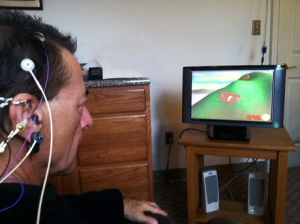The author using his brainwaves to control a computer display
The past decade has seen the proliferation of interface technology, which allows humans to control mobility devices and other sensory-motor applications by electromagnetic pulses issuing from electrodes attached to the scalp. The technology is straightforward, in that the brain emits electromagnetic waves, which are sufficiently specific to allow for the discrimination of a user’s intentions in terms that can be translated into simple commands for controlling input devices.
This is the most basic form of brain/machine interface – using the brain’s electrical potential as a controller to effect a change in the environment. It is another thing entirely to use the electromagnetic signals produced by the brain to change the state of the brain itself – in other words, to use the brain’s output as a form of input in a feedback process.
EEG evidence demonstrates a predictable range of discrete frequencies produced by the brain during specific states of consciousness ranging from deep sleep to wakeful attentiveness. Because there is an observed correlation between the electrical output of the brain and our various states of consciousness, it is possible to “tune” various brain frequencies for optimal states, according to specific performance models.
There are many ways to define “optimal performance”. Specific forms of brain training can be adapted to address specific models of consciousness. Some forms of biofeedback emphasize training for peak performance in the Alpha range and corresponding states of relaxation. Other methods emphasize the production of Theta waves, promoting flowing states of deeper meditation.
Some models of consciousness see the brain as a chaotic system, in which initial conditions and strange attractors form the interconnected landscape of the human mind. In living systems, states of non-linearity and openness to the environment are optimized in healthy individuals, while pathology is described as the system being stuck in repetitive linear patterns. Theories of coherence, resonance, and related ways of looking at wave systems are applied to brain research with varying degrees of efficacy.
Whatever the goal, neuroplasticity ensures the brain can be trained to produce specific frequencies or to exhibit particular patterns in response to specific input. By definition, the brain is a system that learns. And the way it learns is a physical process of reinforcement, exemplified by the axiom “neurons that fire together wire together”. Several popular modalities of neurofeedback provide proprietary algorithms, which are used to process and modify the feedback signals sent back to the subject’s brain.

The author using his brainwaves to control a computer display
I do this work with a psychologist who operates several proprietary systems, and I have equipment that I use at home to practice staying in preferred states of attention or meditation. Some programs employ visual cues to stay focused – flying a video-display airplane or moving various animations in specific patterns. Other systems involve electrical signals induced via optical pathways (using a set of specially-designed glasses), and still others employ audio feedback, electronic sounds, and activating a multimedia player to produce a continuous display. These systems variously train, reinforce, and train the brain to experience and produce more coherent and efficient patterns of energy.
In the next entry of this series, I’ll discuss specific neurofeedback methods in more detail.
*
Brainwave Chart from: alpha-theta-brainwaves.com
Follow Updates on Twitter


